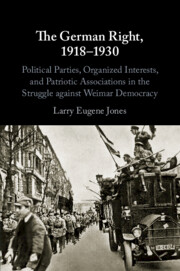 The German Right, 1918–1930
The German Right, 1918–1930 Book contents
- The German Right, 1918–1930
- The German Right, 1918–1930
- Copyright page
- Dedication
- Contents
- Figures
- Acknowledgments
- Abbreviations
- Introduction
- 1 Revolution and Realignment
- 2 Infrastructure of the German Right
- 3 Forging a Conservative Synthesis
- 4 Growth and Consolidation
- 5 The Radical Right
- 6 1923 – A Missed Opportunity?
- 7 From Triumph to Schism
- 8 Stabilization from the Right?
- 9 Paladins of the Right
- 10 A Resurgent Nationalism
- 11 The Road Back to Power
- 12 The Burden of Responsibility
- 13 From Defeat to Crisis
- 14 Reverberations and Realignment
- 15 The Chimera of Right-Wing Unity
- 16 Schism and Fragmentation
- 17 The Brüning Gambit
- 18 The September Earthquake
- Epilogue
- Select Bibliography
- Index
17 - The Brüning Gambit
Published online by Cambridge University Press: 21 March 2020
- The German Right, 1918–1930
- The German Right, 1918–1930
- Copyright page
- Dedication
- Contents
- Figures
- Acknowledgments
- Abbreviations
- Introduction
- 1 Revolution and Realignment
- 2 Infrastructure of the German Right
- 3 Forging a Conservative Synthesis
- 4 Growth and Consolidation
- 5 The Radical Right
- 6 1923 – A Missed Opportunity?
- 7 From Triumph to Schism
- 8 Stabilization from the Right?
- 9 Paladins of the Right
- 10 A Resurgent Nationalism
- 11 The Road Back to Power
- 12 The Burden of Responsibility
- 13 From Defeat to Crisis
- 14 Reverberations and Realignment
- 15 The Chimera of Right-Wing Unity
- 16 Schism and Fragmentation
- 17 The Brüning Gambit
- 18 The September Earthquake
- Epilogue
- Select Bibliography
- Index
Summary
Chapter 17 examines the repercussions of the December secession from the DNVP Reichstag delegation upon the fate of the Müller cabinet and the decision to appoint Heinrich Brüning as the head of a new government based upon the parties of the middle and moderate Right. The architect of the Brüning cabinet was military strategist Kurt von Schleicher, who hoped either to force Hugenberg’s resignation as DNVP party chairman or trigger a second secession on the party’s left wing that was more extensive than the one that had taken place the preceding December. But the support that Hugenberg enjoyed at the base of the DNVP organization was unassailable, with the result that the dissidents within the DNVP Reichstag delegation found themselves increasingly isolated within the party. Consequently, when Hugenberg decided to support Social Democratic efforts to force the dissolution of the Reichstag in July 1930, their only recourse was to leave the party in a second secession that was, to be sure, more extensive than the first but failed to shake Hugenberg’s control of the party.
Keywords
- Type
- Chapter
- Information
- The German Right, 1918–1930Political Parties, Organized Interests, and Patriotic Associations in the Struggle against Weimar Democracy, pp. 524 - 554Publisher: Cambridge University PressPrint publication year: 2020
